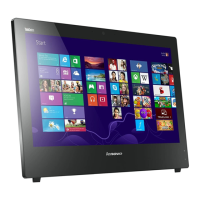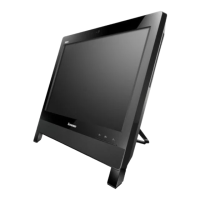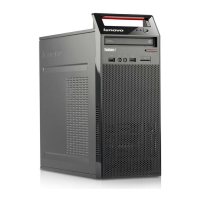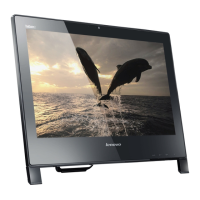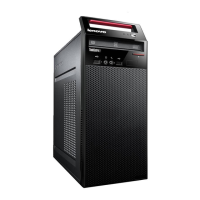
Do you have a question about the Lenovo ThinkCentre E93 and is the answer not in the manual?
| Tcase | 72.72 °C |
|---|---|
| Bus type | DMI2 |
| Stepping | C0 |
| Processor cache | 8 MB |
| Processor cores | 4 |
| System bus rate | 5 GT/s |
| Processor family | Intel® Core™ i7 |
| Processor series | Intel Core i7-4700 Desktop series |
| Processor socket | LGA 1150 (Socket H3) |
| Processor threads | 8 |
| Processor codename | Haswell |
| Processor frequency | 3.4 GHz |
| Processor cache type | Smart Cache |
| Processor lithography | 22 nm |
| Processor manufacturer | Intel |
| Processor front side bus | - MHz |
| PCI Express slots version | 3.0 |
| Processor boost frequency | 3.9 GHz |
| Processor operating modes | 64-bit |
| ECC supported by processor | No |
| PCI Express configurations | 1x16, 2x8, 1x8+2x4 |
| Thermal Design Power (TDP) | 84 W |
| Number of processors installed | 1 |
| Maximum number of PCI Express lanes | 16 |
| Memory types supported by processor | DDR3-SDRAM |
| Memory voltage supported by processor | 1.5 V |
| Memory clock speeds supported by processor | 1333, 1600 MHz |
| Memory bandwidth supported by processor (max) | 25.6 GB/s |
| Maximum internal memory supported by processor | 32 GB |
| Memory slots | 4x DIMM |
| Internal memory | 4 GB |
| Memory channels | Dual-channel |
| Memory clock speed | 1600 MHz |
| Memory layout (slots x size) | 1 x 4 GB |
| HDD speed | 7200 RPM |
| HDD interface | SATA |
| Storage media | HDD |
| Optical drive type | DVD±RW |
| Card reader integrated | Yes |
| Total storage capacity | 1000 GB |
| Intel® Virtualization Technology (Intel® VT) | VT-d, VT-x |
| On-board graphics card ID | 0x412 |
| Discrete graphics card model | - |
| On-board graphics card model | Intel® HD Graphics 4600 |
| On-board graphics card family | Intel® HD Graphics |
| Maximum on-board graphics card memory | 2 GB |
| On-board graphics card OpenGL version | 4.3 |
| On-board graphics card base frequency | 350 MHz |
| On-board graphics card DirectX version | 11.2/12 |
| On-board graphics card dynamic frequency (max) | 1200 MHz |
| Number of displays supported (on-board graphics) | 3 |
| Recovery operating system | Windows 8.1 Pro |
| Operating system installed | Windows 7 Professional |
| Cabling technology | 10/100/1000Base-T(X) |
| Ethernet LAN data rates | 10, 100, 1000 Mbit/s |
| USB 2.0 ports quantity | USB 2.0 ports have a data transmission speed of 480 Mbps, and are backwards compatible with USB 1.1 ports. You can connect all kinds of peripheral devices to them. |
| USB 3.2 Gen 2 (3.1 Gen 2) Type-A ports quantity | 0 |
| PCI Express x1 slots | 2 |
| Chassis type | Tower |
| Product color | Black |
| Cable lock slot type | Kensington |
| Product type | PC |
| Motherboard chipset | Intel® B85 |
| Scalability | 1S |
| Processor code | SR149 |
| Processor ARK ID | 75122 |
| Intel TSX-NI version | 0.00 |
| Processor package size | 37.5 x 37.5 mm |
| Supported instruction sets | AVX 2.0, SSE4.1, SSE4.2 |
| Thermal solution specification | PCG 2013D |
| Intel Identity Protection Technology version | 1.00 |
| Power supply | 280 W |
| Power supply input voltage | 100 - 240 V |
| Power supply input frequency | 50 - 60 Hz |
| Sustainability certificates | RoHS, EPEAT Gold, ENERGY STAR |
| Depth | 390 mm |
|---|---|
| Width | 160 mm |
| Height | 397 mm |
| Weight | 7000 g |
Guidelines to prevent damage to computer components from static electricity during handling.
Safety precautions for using power cords and adapters, including proper routing and avoiding damage.
Overview of the security features available on the computer to prevent theft and unauthorized use.
Precautions to avoid static electricity damage when installing or replacing computer parts.
Step-by-step instructions for safely removing the computer's outer cover.
Procedure for installing or replacing DDR3 memory modules in the computer's slots.
Instructions for creating and using recovery media to restore the computer to factory default state.
Procedure for accessing the computer's BIOS Setup Utility program.
Information on setting and managing BIOS passwords for system access and security.
General steps to identify and resolve common computer problems.
